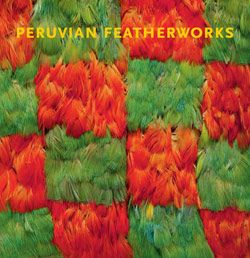Scepter wand with feathers
Para español, véase más abajo.
The corpus of featherworks that has survived to the present day, along with accounts written by sixteenth-century Spanish chroniclers who described Andean traditions at the time of the Inca Empire, suggest that feathers in ancient Peru were mainly used to embellish tunics or tabards, headdresses, and accessories that high-ranking individuals wore or exchanged during ceremonies and festive occasions. Feathers were chosen primarily for their radiant colors, striking iridescence, and silken textures, properties that could not be easily achieved with natural fabric dyes. In addition to using feathers from birds native to the coast and highlands, from the seventh century onwards Andean artists increasingly incorporated the bright feathers of Amazonian birds into their creations, a tradition that slowly disappeared in the early sixteenth century, after the Spanish conquest.
Created by featherworkers of the Chimú culture on Peru’s North Coast in the centuries before the rise of the Inca, this silver scepter consists of a long hollow shaft with a loop handle at one end, while the other is topped by a globe with funnel from which yellow macaw feathers emerge. This object and others in the museum’s collection (see, for example, 1987.394.655, 1987.394.656) are said to be from a single tomb found ca. 1968-1969 in the Chancay Valley, north of Lima. All the components of this find are miniatures: vessels, musical instruments, items of clothing, tools, weapons, and even effigies of flowers and trees. While initially believed to be children’s toys (these were said to have been found in a child’s burial), they are most likely votive offerings, ritually buried to petition the gods for favors, a tradition that peaked in Inca times.
Carol Rodríguez, The Michael C. Rockefeller Wing Resident for the Art of the Ancient Americas, 2025
References
Rowe, Ann P. Costumes and Featherwork of the Lords of Chimor: Textiles from Peru's North Coast. Washington, DC: Textile Museum, 1984, p. 157, no. 157.
King, Heidi, Luis Jaime Castillo Butters, and Paloma Carcedo de Mufarech. Rain of the Moon: Silver in Ancient Peru. New York, New Haven and London: The Metropolitan Museum of Art, 2000, p. 48, no.19.
King, Heidi. Peruvian Featherworks: Art of the Precolumbian Era. New York: The Metropolitan Museum of Art, 2012, p. 198.
Further Reading
King, Heidi, Luis Jaime Castillo Butters, and Paloma Carcedo de Mufarech. Rain of the Moon: Silver in Ancient Peru. New York, New Haven and London: The Metropolitan Museum of Art, 2000.
King, Heidi. Peruvian Featherworks: Art of the Precolumbian Era. New York: The Metropolitan Museum of Art, 2012.
Rowe, Ann P. Costumes and Featherwork of the Lords of Chimor: Textiles from Peru's North Coast. Washington, DC: Textile Museum, 1984.
Wikilson, Darryl. “The influence of Amazonia on state formation in the ancient Andes.” Antiquity, volume 92, issue 365 (October 2018).
El corpus de objetos decorados con plumas que existe hoy en día, junto con los relatos escritos por los cronistas españoles del siglo XVI que describen las tradiciones andinas en la época del Imperio Inca, sugieren que las plumas en el antiguo Perú se utilizaban principalmente para embellecer túnicas o tabardos, tocados, y accesorios que individuos de alto estatus vestían o intercambiaban durante ceremonias y ocasiones festivas. Las plumas eran elegidas principalmente por sus colores radiantes, su llamativa iridiscencia y sus texturas sedosas, propiedades que no podían conseguirse fácilmente con tintes naturales para textiles. Además de utilizar plumas de aves nativas de la costa y sierra, a partir del siglo VII los artistas andinos incorporaron cada vez más las brillantes plumas de las aves amazónicas, una tradición que desapareció lentamente a principios del siglo XVI tras la conquista española.
Creada por artistas de la cultura Chimú de la costa norte del Perú, en los siglos anteriores al auge de los incas, esta vara de plata consta de un cuerpo hueco con un mango en forma de lazo en un extremo, mientras que el otro ha sido rematado por un globo en forma de embudo desde donde brotan plumas amarillas de guacamayo. Se dice que este objeto y otros en la colección del museo (ver, por ejemplo, 1987.394.655, 1987.394.656) formaron parte de una tumba descubierta hacia 1968-1969 en el valle de Chancay, al norte de Lima. Todos los componentes de este hallazgo son miniaturas: vasijas, instrumentos musicales, vestimentas, herramientas, armas e incluso efigies de flores y árboles. Aunque al principio se pensó que eran juguetes para niños (se dice que estas piezas fueron halladas en el entierro de un infante), es más probable que se trate de ofrendas enterradas ritualmente para pedir favores a los dioses, una tradición que alcanzó su apogeo en el tiempo de los incas.
Carol Rodríguez, The Michael C. Rockefeller Wing Resident for the Art of the Ancient Americas, 2025
Referencias
Rowe, Ann P. Costumes and Featherwork of the Lords of Chimor: Textiles from Peru's North Coast. Washington, DC: Textile Museum, 1984, p. 157, no. 157.
King, Heidi, Luis Jaime Castillo Butters, y Paloma Carcedo de Mufarech. Rain of the Moon: Silver in Ancient Peru. New York, New Haven and London: The Metropolitan Museum of Art, 2000, p. 48, no.19.
King, Heidi. Peruvian Featherworks: Art of the Precolumbian Era. New York: The Metropolitan Museum of Art, 2012, p. 198.
Lecturas adicionales
King, Heidi, Luis Jaime Castillo Butters, y Paloma Carcedo de Mufarech. Rain of the Moon: Silver in Ancient Peru. New York, New Haven and London: The Metropolitan Museum of Art, 2000.
King, Heidi. Peruvian Featherworks: Art of the Precolumbian Era. New York: The Metropolitan Museum of Art, 2012.
Rowe, Ann P. Costumes and Featherwork of the Lords of Chimor: Textiles from Peru's North Coast. Washington, DC: Textile Museum, 1984.
Wikilson, Darryl. “The influence of Amazonia on state formation in the ancient Andes.” Antiquity, volume 92, issue 365 (October 2018).
This image cannot be enlarged, viewed at full screen, or downloaded.


